Monash University NUR4111: Developing BLS Teaching Plan
VerifiedAdded on 2022/08/22
|16
|3423
|13
Project
AI Summary
This project presents a comprehensive teaching plan for Basic Life Support (BLS) designed for first-year nursing students in a clinical learning environment. The plan, developed by a third-year nursing student, addresses the critical need for BLS knowledge and skills among nurses, emphasizing its importance in emergency situations like cardiopulmonary resuscitation (CPR). The assignment is structured into three main sections: Background, Lesson Plan, and Feedback and Evaluation Considerations. The Background section provides an introduction to BLS, pre-teaching considerations, including target audience, learning styles, and the teaching context. The Lesson Plan outlines the teaching session's purpose, learning outcomes, timing, content, activities, resources, and evaluation methods. The feedback and evaluation section details how feedback will be provided and how the learner's competence will be assessed, with a strong emphasis on evidence-based practices. The plan covers essential elements like recognizing the need for BLS, performing CPR, and adapting BLS for different patient populations. The teaching approach incorporates practical-based learning, audio-visual sessions, and peer teaching to enhance student understanding and skills. The evaluation methods include revision quizzes, practical demonstrations, and questionnaires to assess the students' grasp of the subject matter and their ability to apply the learned skills in clinical settings. Finally, the plan includes considerations for post-recovery care and a summary of the session.
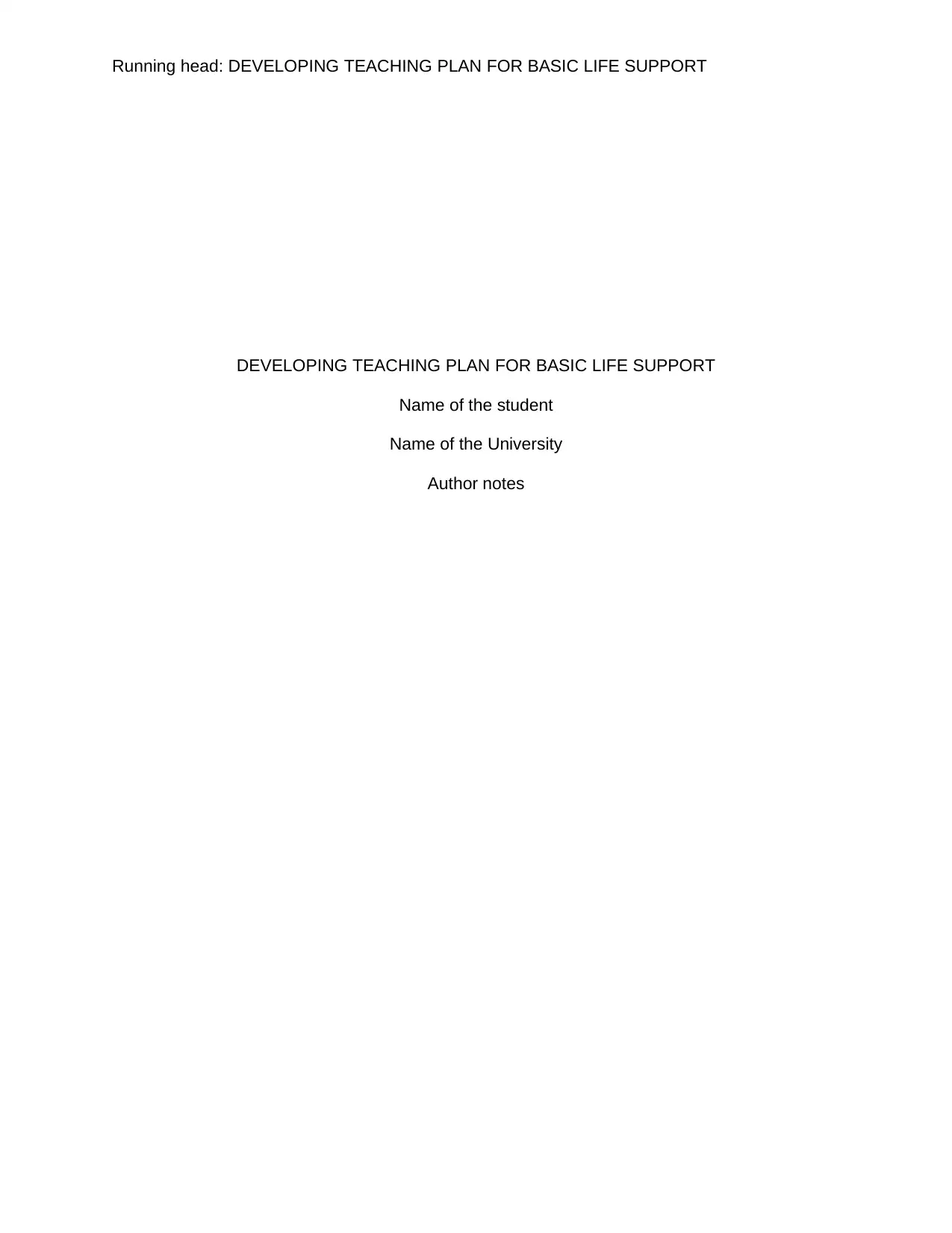
Running head: DEVELOPING TEACHING PLAN FOR BASIC LIFE SUPPORT
DEVELOPING TEACHING PLAN FOR BASIC LIFE SUPPORT
Name of the student
Name of the University
Author notes
DEVELOPING TEACHING PLAN FOR BASIC LIFE SUPPORT
Name of the student
Name of the University
Author notes
Paraphrase This Document
Need a fresh take? Get an instant paraphrase of this document with our AI Paraphraser
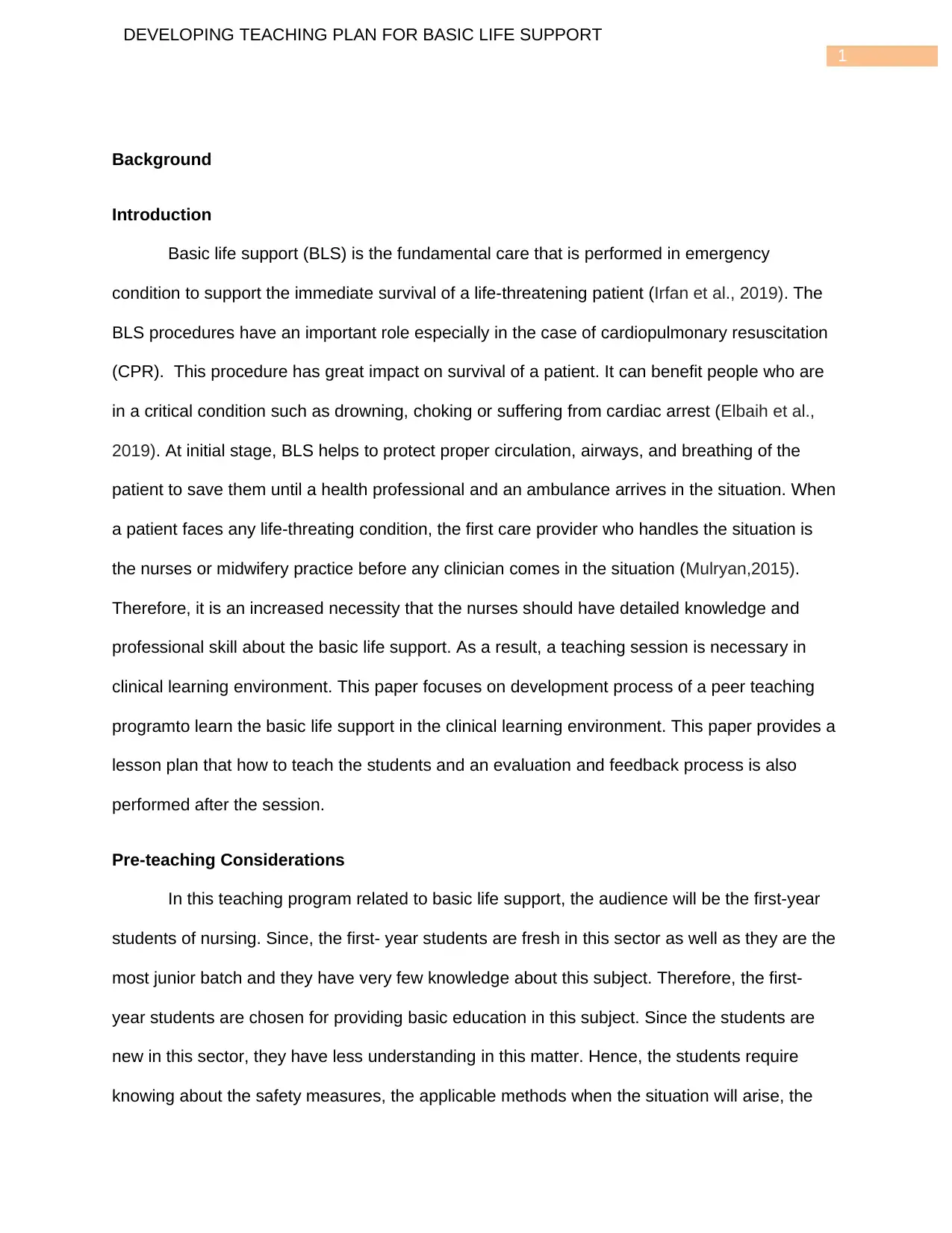
1
DEVELOPING TEACHING PLAN FOR BASIC LIFE SUPPORT
Background
Introduction
Basic life support (BLS) is the fundamental care that is performed in emergency
condition to support the immediate survival of a life-threatening patient (Irfan et al., 2019). The
BLS procedures have an important role especially in the case of cardiopulmonary resuscitation
(CPR). This procedure has great impact on survival of a patient. It can benefit people who are
in a critical condition such as drowning, choking or suffering from cardiac arrest (Elbaih et al.,
2019). At initial stage, BLS helps to protect proper circulation, airways, and breathing of the
patient to save them until a health professional and an ambulance arrives in the situation. When
a patient faces any life-threating condition, the first care provider who handles the situation is
the nurses or midwifery practice before any clinician comes in the situation (Mulryan,2015).
Therefore, it is an increased necessity that the nurses should have detailed knowledge and
professional skill about the basic life support. As a result, a teaching session is necessary in
clinical learning environment. This paper focuses on development process of a peer teaching
programto learn the basic life support in the clinical learning environment. This paper provides a
lesson plan that how to teach the students and an evaluation and feedback process is also
performed after the session.
Pre-teaching Considerations
In this teaching program related to basic life support, the audience will be the first-year
students of nursing. Since, the first- year students are fresh in this sector as well as they are the
most junior batch and they have very few knowledge about this subject. Therefore, the first-
year students are chosen for providing basic education in this subject. Since the students are
new in this sector, they have less understanding in this matter. Hence, the students require
knowing about the safety measures, the applicable methods when the situation will arise, the
DEVELOPING TEACHING PLAN FOR BASIC LIFE SUPPORT
Background
Introduction
Basic life support (BLS) is the fundamental care that is performed in emergency
condition to support the immediate survival of a life-threatening patient (Irfan et al., 2019). The
BLS procedures have an important role especially in the case of cardiopulmonary resuscitation
(CPR). This procedure has great impact on survival of a patient. It can benefit people who are
in a critical condition such as drowning, choking or suffering from cardiac arrest (Elbaih et al.,
2019). At initial stage, BLS helps to protect proper circulation, airways, and breathing of the
patient to save them until a health professional and an ambulance arrives in the situation. When
a patient faces any life-threating condition, the first care provider who handles the situation is
the nurses or midwifery practice before any clinician comes in the situation (Mulryan,2015).
Therefore, it is an increased necessity that the nurses should have detailed knowledge and
professional skill about the basic life support. As a result, a teaching session is necessary in
clinical learning environment. This paper focuses on development process of a peer teaching
programto learn the basic life support in the clinical learning environment. This paper provides a
lesson plan that how to teach the students and an evaluation and feedback process is also
performed after the session.
Pre-teaching Considerations
In this teaching program related to basic life support, the audience will be the first-year
students of nursing. Since, the first- year students are fresh in this sector as well as they are the
most junior batch and they have very few knowledge about this subject. Therefore, the first-
year students are chosen for providing basic education in this subject. Since the students are
new in this sector, they have less understanding in this matter. Hence, the students require
knowing about the safety measures, the applicable methods when the situation will arise, the
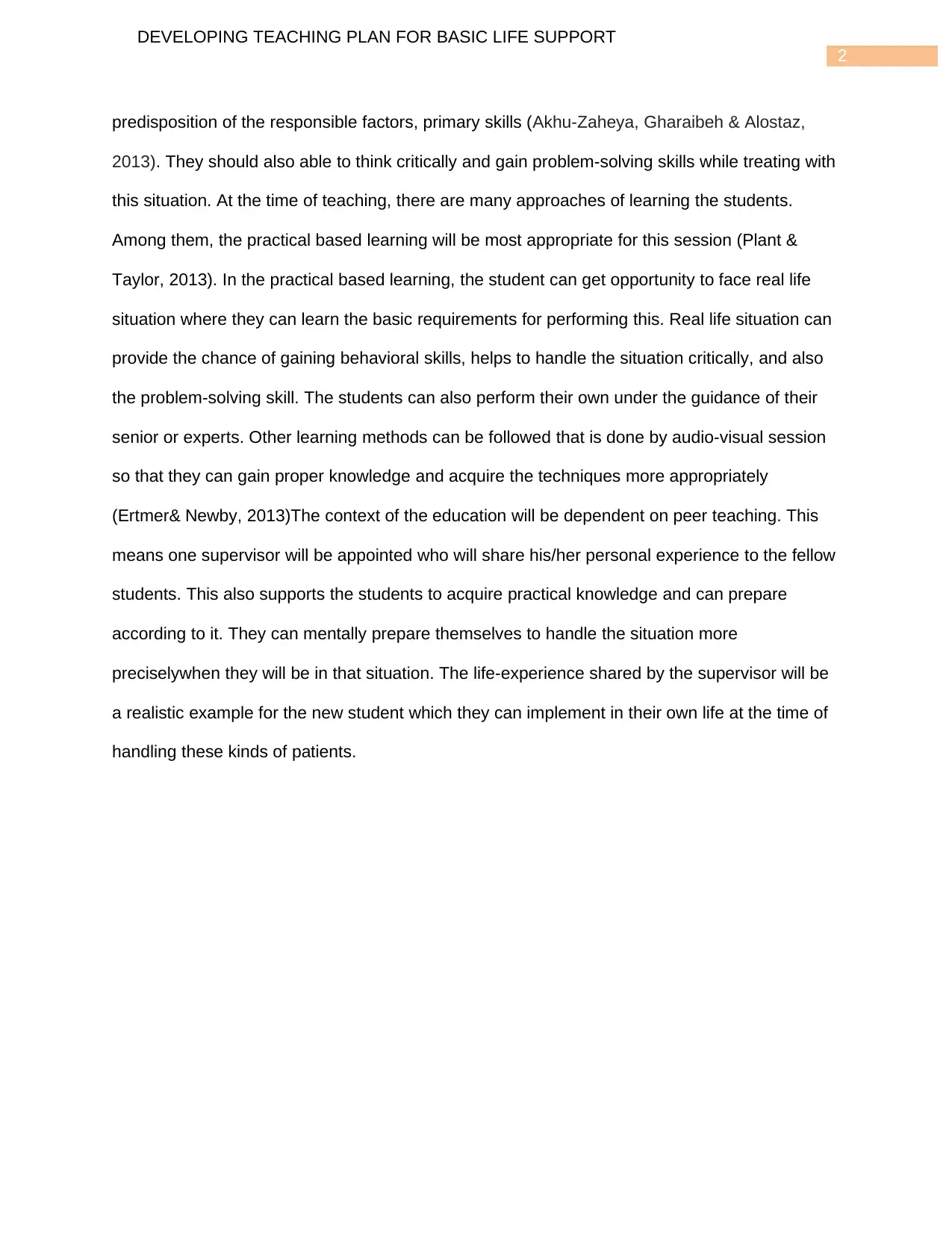
2
DEVELOPING TEACHING PLAN FOR BASIC LIFE SUPPORT
predisposition of the responsible factors, primary skills (Akhu-Zaheya, Gharaibeh & Alostaz,
2013). They should also able to think critically and gain problem-solving skills while treating with
this situation. At the time of teaching, there are many approaches of learning the students.
Among them, the practical based learning will be most appropriate for this session (Plant &
Taylor, 2013). In the practical based learning, the student can get opportunity to face real life
situation where they can learn the basic requirements for performing this. Real life situation can
provide the chance of gaining behavioral skills, helps to handle the situation critically, and also
the problem-solving skill. The students can also perform their own under the guidance of their
senior or experts. Other learning methods can be followed that is done by audio-visual session
so that they can gain proper knowledge and acquire the techniques more appropriately
(Ertmer& Newby, 2013)The context of the education will be dependent on peer teaching. This
means one supervisor will be appointed who will share his/her personal experience to the fellow
students. This also supports the students to acquire practical knowledge and can prepare
according to it. They can mentally prepare themselves to handle the situation more
preciselywhen they will be in that situation. The life-experience shared by the supervisor will be
a realistic example for the new student which they can implement in their own life at the time of
handling these kinds of patients.
DEVELOPING TEACHING PLAN FOR BASIC LIFE SUPPORT
predisposition of the responsible factors, primary skills (Akhu-Zaheya, Gharaibeh & Alostaz,
2013). They should also able to think critically and gain problem-solving skills while treating with
this situation. At the time of teaching, there are many approaches of learning the students.
Among them, the practical based learning will be most appropriate for this session (Plant &
Taylor, 2013). In the practical based learning, the student can get opportunity to face real life
situation where they can learn the basic requirements for performing this. Real life situation can
provide the chance of gaining behavioral skills, helps to handle the situation critically, and also
the problem-solving skill. The students can also perform their own under the guidance of their
senior or experts. Other learning methods can be followed that is done by audio-visual session
so that they can gain proper knowledge and acquire the techniques more appropriately
(Ertmer& Newby, 2013)The context of the education will be dependent on peer teaching. This
means one supervisor will be appointed who will share his/her personal experience to the fellow
students. This also supports the students to acquire practical knowledge and can prepare
according to it. They can mentally prepare themselves to handle the situation more
preciselywhen they will be in that situation. The life-experience shared by the supervisor will be
a realistic example for the new student which they can implement in their own life at the time of
handling these kinds of patients.
⊘ This is a preview!⊘
Do you want full access?
Subscribe today to unlock all pages.

Trusted by 1+ million students worldwide
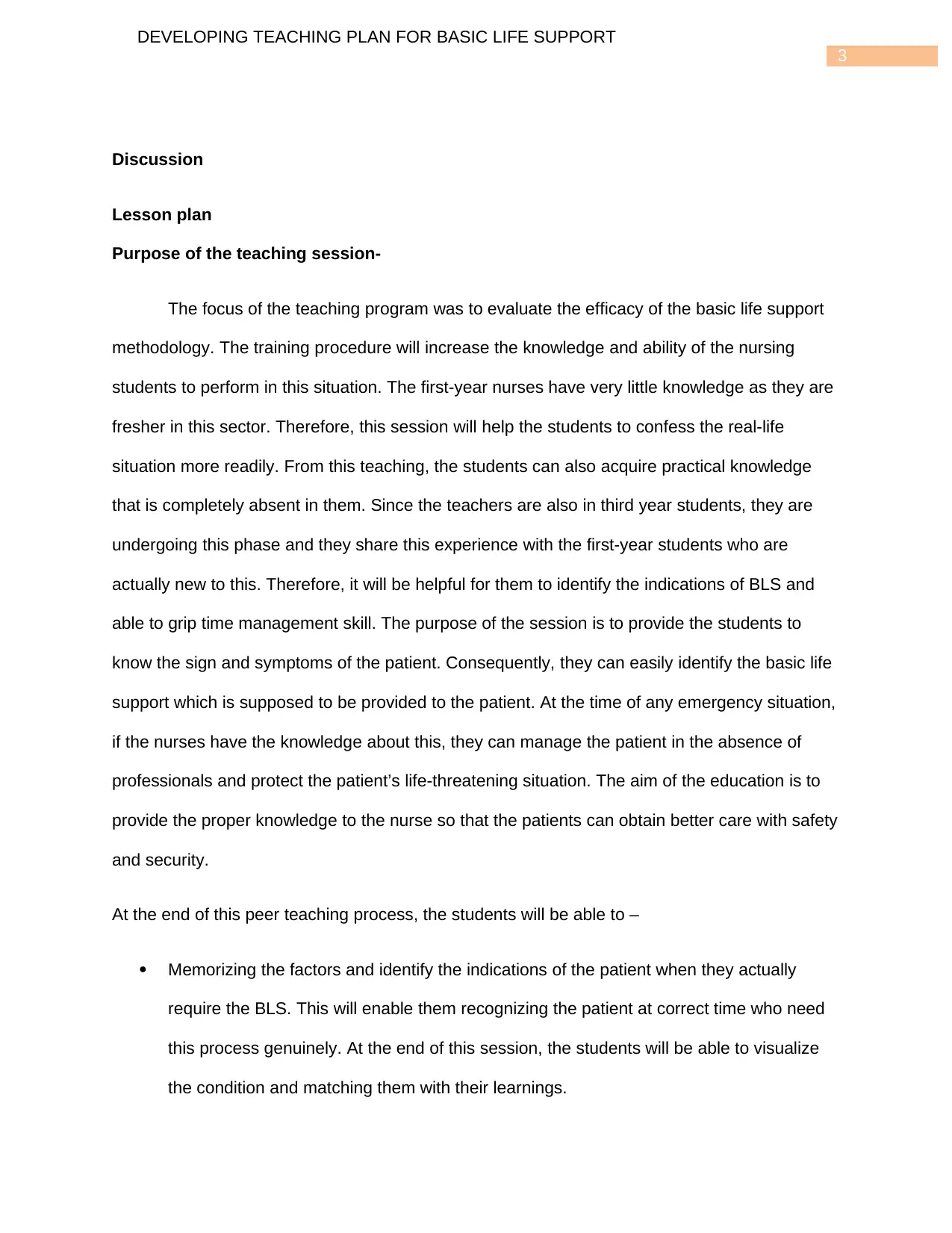
3
DEVELOPING TEACHING PLAN FOR BASIC LIFE SUPPORT
Discussion
Lesson plan
Purpose of the teaching session-
The focus of the teaching program was to evaluate the efficacy of the basic life support
methodology. The training procedure will increase the knowledge and ability of the nursing
students to perform in this situation. The first-year nurses have very little knowledge as they are
fresher in this sector. Therefore, this session will help the students to confess the real-life
situation more readily. From this teaching, the students can also acquire practical knowledge
that is completely absent in them. Since the teachers are also in third year students, they are
undergoing this phase and they share this experience with the first-year students who are
actually new to this. Therefore, it will be helpful for them to identify the indications of BLS and
able to grip time management skill. The purpose of the session is to provide the students to
know the sign and symptoms of the patient. Consequently, they can easily identify the basic life
support which is supposed to be provided to the patient. At the time of any emergency situation,
if the nurses have the knowledge about this, they can manage the patient in the absence of
professionals and protect the patient’s life-threatening situation. The aim of the education is to
provide the proper knowledge to the nurse so that the patients can obtain better care with safety
and security.
At the end of this peer teaching process, the students will be able to –
Memorizing the factors and identify the indications of the patient when they actually
require the BLS. This will enable them recognizing the patient at correct time who need
this process genuinely. At the end of this session, the students will be able to visualize
the condition and matching them with their learnings.
DEVELOPING TEACHING PLAN FOR BASIC LIFE SUPPORT
Discussion
Lesson plan
Purpose of the teaching session-
The focus of the teaching program was to evaluate the efficacy of the basic life support
methodology. The training procedure will increase the knowledge and ability of the nursing
students to perform in this situation. The first-year nurses have very little knowledge as they are
fresher in this sector. Therefore, this session will help the students to confess the real-life
situation more readily. From this teaching, the students can also acquire practical knowledge
that is completely absent in them. Since the teachers are also in third year students, they are
undergoing this phase and they share this experience with the first-year students who are
actually new to this. Therefore, it will be helpful for them to identify the indications of BLS and
able to grip time management skill. The purpose of the session is to provide the students to
know the sign and symptoms of the patient. Consequently, they can easily identify the basic life
support which is supposed to be provided to the patient. At the time of any emergency situation,
if the nurses have the knowledge about this, they can manage the patient in the absence of
professionals and protect the patient’s life-threatening situation. The aim of the education is to
provide the proper knowledge to the nurse so that the patients can obtain better care with safety
and security.
At the end of this peer teaching process, the students will be able to –
Memorizing the factors and identify the indications of the patient when they actually
require the BLS. This will enable them recognizing the patient at correct time who need
this process genuinely. At the end of this session, the students will be able to visualize
the condition and matching them with their learnings.
Paraphrase This Document
Need a fresh take? Get an instant paraphrase of this document with our AI Paraphraser
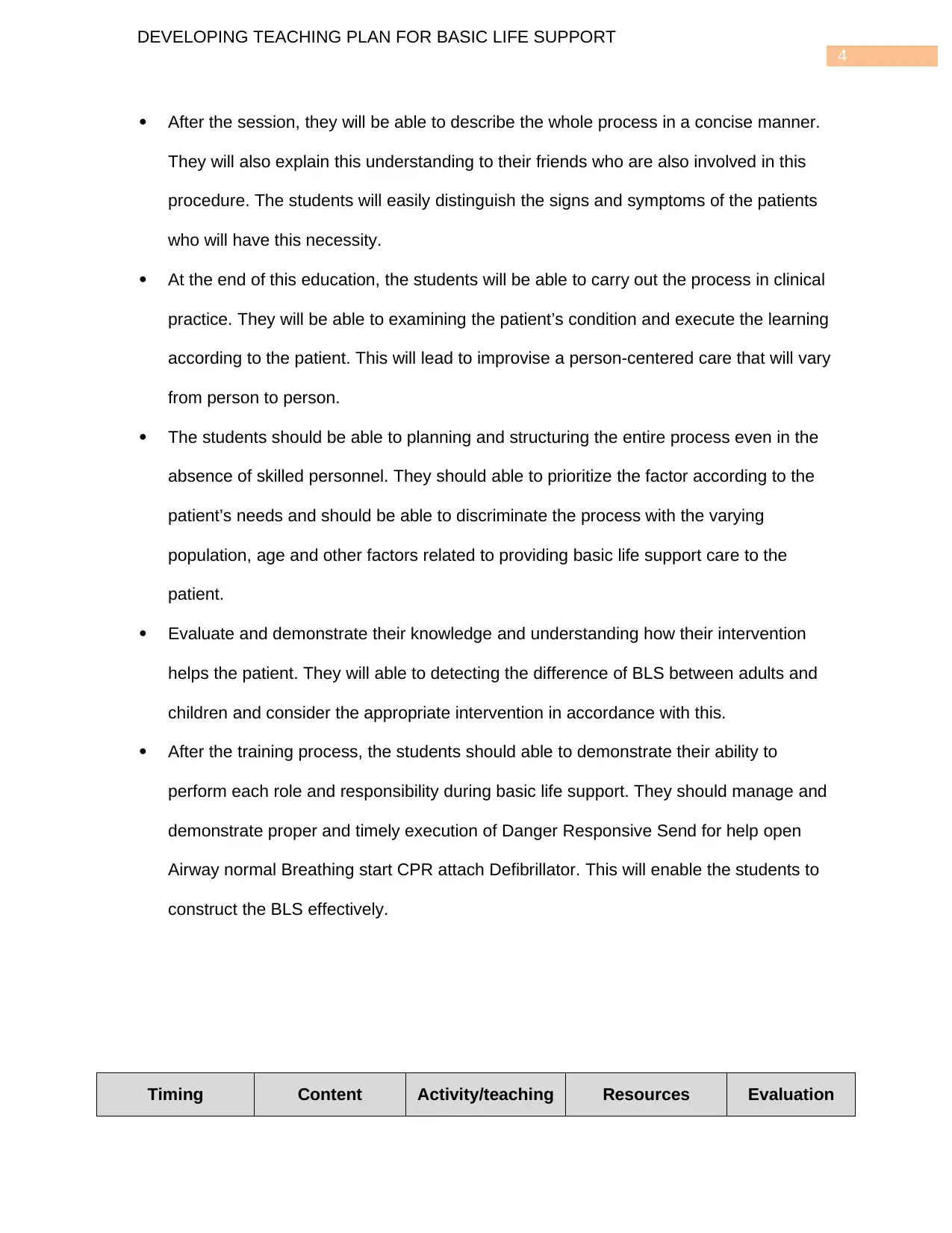
4
DEVELOPING TEACHING PLAN FOR BASIC LIFE SUPPORT
After the session, they will be able to describe the whole process in a concise manner.
They will also explain this understanding to their friends who are also involved in this
procedure. The students will easily distinguish the signs and symptoms of the patients
who will have this necessity.
At the end of this education, the students will be able to carry out the process in clinical
practice. They will be able to examining the patient’s condition and execute the learning
according to the patient. This will lead to improvise a person-centered care that will vary
from person to person.
The students should be able to planning and structuring the entire process even in the
absence of skilled personnel. They should able to prioritize the factor according to the
patient’s needs and should be able to discriminate the process with the varying
population, age and other factors related to providing basic life support care to the
patient.
Evaluate and demonstrate their knowledge and understanding how their intervention
helps the patient. They will able to detecting the difference of BLS between adults and
children and consider the appropriate intervention in accordance with this.
After the training process, the students should able to demonstrate their ability to
perform each role and responsibility during basic life support. They should manage and
demonstrate proper and timely execution of Danger Responsive Send for help open
Airway normal Breathing start CPR attach Defibrillator. This will enable the students to
construct the BLS effectively.
Timing Content Activity/teaching Resources Evaluation
DEVELOPING TEACHING PLAN FOR BASIC LIFE SUPPORT
After the session, they will be able to describe the whole process in a concise manner.
They will also explain this understanding to their friends who are also involved in this
procedure. The students will easily distinguish the signs and symptoms of the patients
who will have this necessity.
At the end of this education, the students will be able to carry out the process in clinical
practice. They will be able to examining the patient’s condition and execute the learning
according to the patient. This will lead to improvise a person-centered care that will vary
from person to person.
The students should be able to planning and structuring the entire process even in the
absence of skilled personnel. They should able to prioritize the factor according to the
patient’s needs and should be able to discriminate the process with the varying
population, age and other factors related to providing basic life support care to the
patient.
Evaluate and demonstrate their knowledge and understanding how their intervention
helps the patient. They will able to detecting the difference of BLS between adults and
children and consider the appropriate intervention in accordance with this.
After the training process, the students should able to demonstrate their ability to
perform each role and responsibility during basic life support. They should manage and
demonstrate proper and timely execution of Danger Responsive Send for help open
Airway normal Breathing start CPR attach Defibrillator. This will enable the students to
construct the BLS effectively.
Timing Content Activity/teaching Resources Evaluation
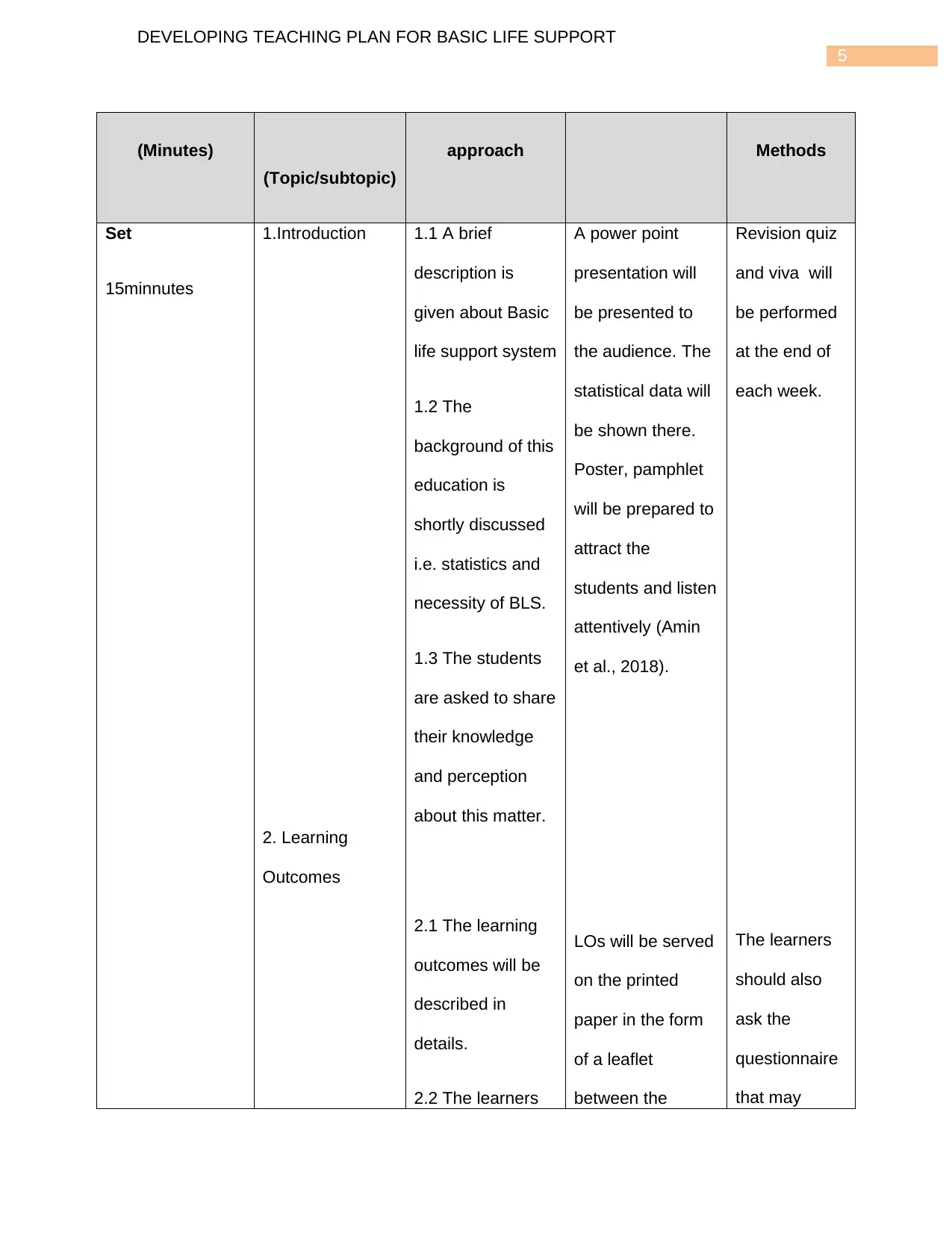
5
DEVELOPING TEACHING PLAN FOR BASIC LIFE SUPPORT
(Minutes)
(Topic/subtopic)
approach Methods
Set
15minnutes
1.Introduction
2. Learning
Outcomes
1.1 A brief
description is
given about Basic
life support system
1.2 The
background of this
education is
shortly discussed
i.e. statistics and
necessity of BLS.
1.3 The students
are asked to share
their knowledge
and perception
about this matter.
2.1 The learning
outcomes will be
described in
details.
2.2 The learners
A power point
presentation will
be presented to
the audience. The
statistical data will
be shown there.
Poster, pamphlet
will be prepared to
attract the
students and listen
attentively (Amin
et al., 2018).
LOs will be served
on the printed
paper in the form
of a leaflet
between the
Revision quiz
and viva will
be performed
at the end of
each week.
The learners
should also
ask the
questionnaire
that may
DEVELOPING TEACHING PLAN FOR BASIC LIFE SUPPORT
(Minutes)
(Topic/subtopic)
approach Methods
Set
15minnutes
1.Introduction
2. Learning
Outcomes
1.1 A brief
description is
given about Basic
life support system
1.2 The
background of this
education is
shortly discussed
i.e. statistics and
necessity of BLS.
1.3 The students
are asked to share
their knowledge
and perception
about this matter.
2.1 The learning
outcomes will be
described in
details.
2.2 The learners
A power point
presentation will
be presented to
the audience. The
statistical data will
be shown there.
Poster, pamphlet
will be prepared to
attract the
students and listen
attentively (Amin
et al., 2018).
LOs will be served
on the printed
paper in the form
of a leaflet
between the
Revision quiz
and viva will
be performed
at the end of
each week.
The learners
should also
ask the
questionnaire
that may
⊘ This is a preview!⊘
Do you want full access?
Subscribe today to unlock all pages.

Trusted by 1+ million students worldwide
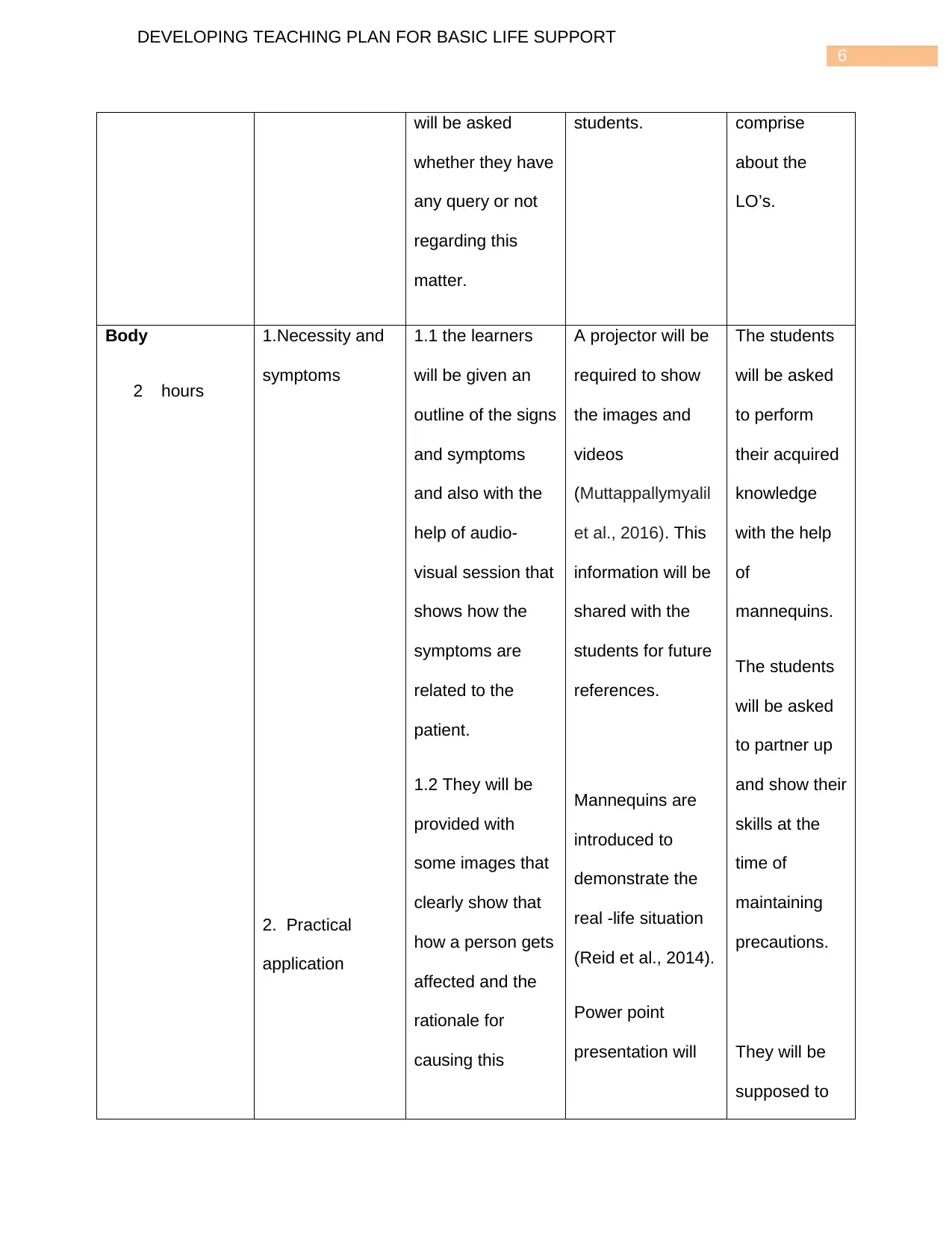
6
DEVELOPING TEACHING PLAN FOR BASIC LIFE SUPPORT
will be asked
whether they have
any query or not
regarding this
matter.
students. comprise
about the
LO’s.
Body
2 hours
1.Necessity and
symptoms
2. Practical
application
1.1 the learners
will be given an
outline of the signs
and symptoms
and also with the
help of audio-
visual session that
shows how the
symptoms are
related to the
patient.
1.2 They will be
provided with
some images that
clearly show that
how a person gets
affected and the
rationale for
causing this
A projector will be
required to show
the images and
videos
(Muttappallymyalil
et al., 2016). This
information will be
shared with the
students for future
references.
Mannequins are
introduced to
demonstrate the
real -life situation
(Reid et al., 2014).
Power point
presentation will
The students
will be asked
to perform
their acquired
knowledge
with the help
of
mannequins.
The students
will be asked
to partner up
and show their
skills at the
time of
maintaining
precautions.
They will be
supposed to
DEVELOPING TEACHING PLAN FOR BASIC LIFE SUPPORT
will be asked
whether they have
any query or not
regarding this
matter.
students. comprise
about the
LO’s.
Body
2 hours
1.Necessity and
symptoms
2. Practical
application
1.1 the learners
will be given an
outline of the signs
and symptoms
and also with the
help of audio-
visual session that
shows how the
symptoms are
related to the
patient.
1.2 They will be
provided with
some images that
clearly show that
how a person gets
affected and the
rationale for
causing this
A projector will be
required to show
the images and
videos
(Muttappallymyalil
et al., 2016). This
information will be
shared with the
students for future
references.
Mannequins are
introduced to
demonstrate the
real -life situation
(Reid et al., 2014).
Power point
presentation will
The students
will be asked
to perform
their acquired
knowledge
with the help
of
mannequins.
The students
will be asked
to partner up
and show their
skills at the
time of
maintaining
precautions.
They will be
supposed to
Paraphrase This Document
Need a fresh take? Get an instant paraphrase of this document with our AI Paraphraser
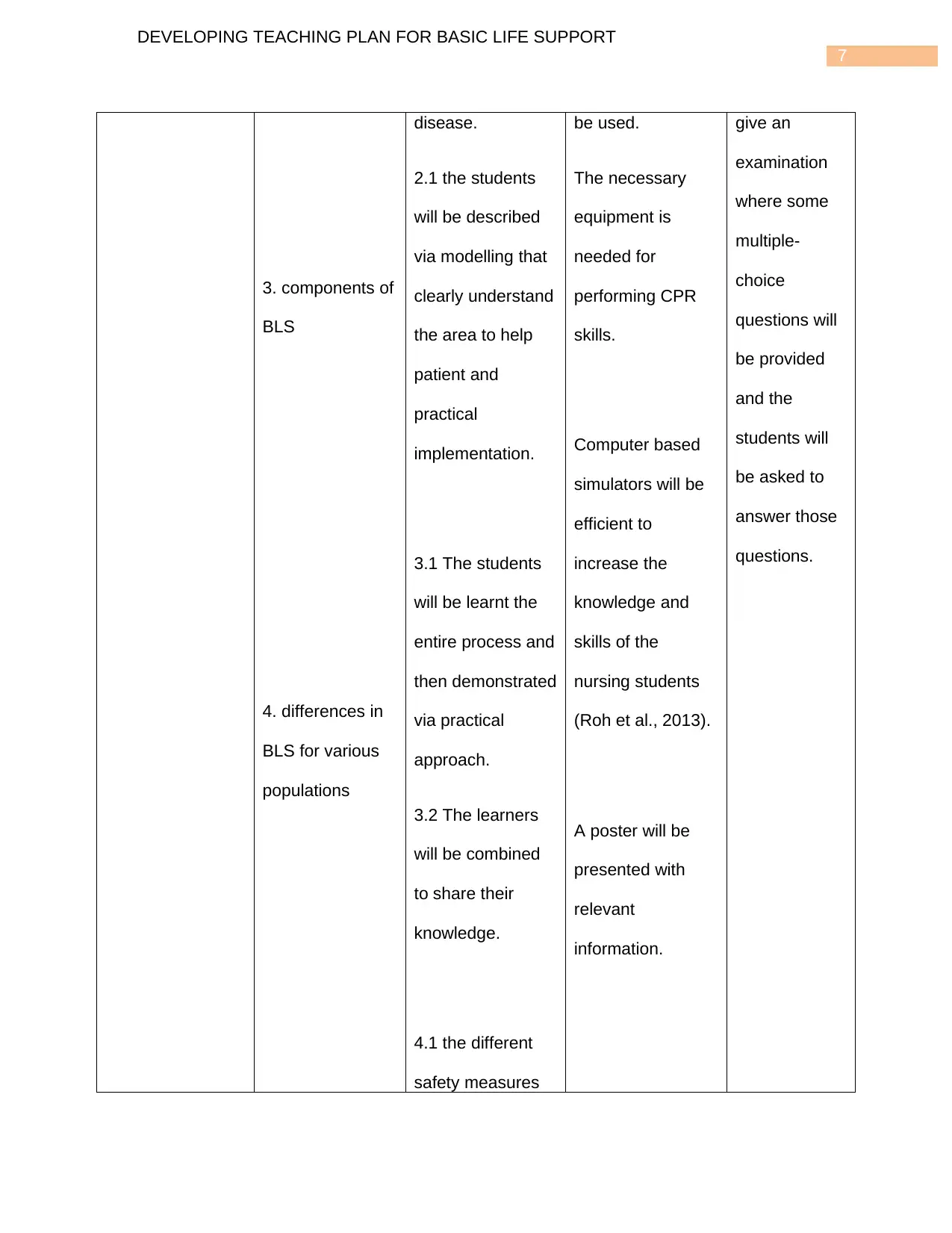
7
DEVELOPING TEACHING PLAN FOR BASIC LIFE SUPPORT
3. components of
BLS
4. differences in
BLS for various
populations
disease.
2.1 the students
will be described
via modelling that
clearly understand
the area to help
patient and
practical
implementation.
3.1 The students
will be learnt the
entire process and
then demonstrated
via practical
approach.
3.2 The learners
will be combined
to share their
knowledge.
4.1 the different
safety measures
be used.
The necessary
equipment is
needed for
performing CPR
skills.
Computer based
simulators will be
efficient to
increase the
knowledge and
skills of the
nursing students
(Roh et al., 2013).
A poster will be
presented with
relevant
information.
give an
examination
where some
multiple-
choice
questions will
be provided
and the
students will
be asked to
answer those
questions.
DEVELOPING TEACHING PLAN FOR BASIC LIFE SUPPORT
3. components of
BLS
4. differences in
BLS for various
populations
disease.
2.1 the students
will be described
via modelling that
clearly understand
the area to help
patient and
practical
implementation.
3.1 The students
will be learnt the
entire process and
then demonstrated
via practical
approach.
3.2 The learners
will be combined
to share their
knowledge.
4.1 the different
safety measures
be used.
The necessary
equipment is
needed for
performing CPR
skills.
Computer based
simulators will be
efficient to
increase the
knowledge and
skills of the
nursing students
(Roh et al., 2013).
A poster will be
presented with
relevant
information.
give an
examination
where some
multiple-
choice
questions will
be provided
and the
students will
be asked to
answer those
questions.
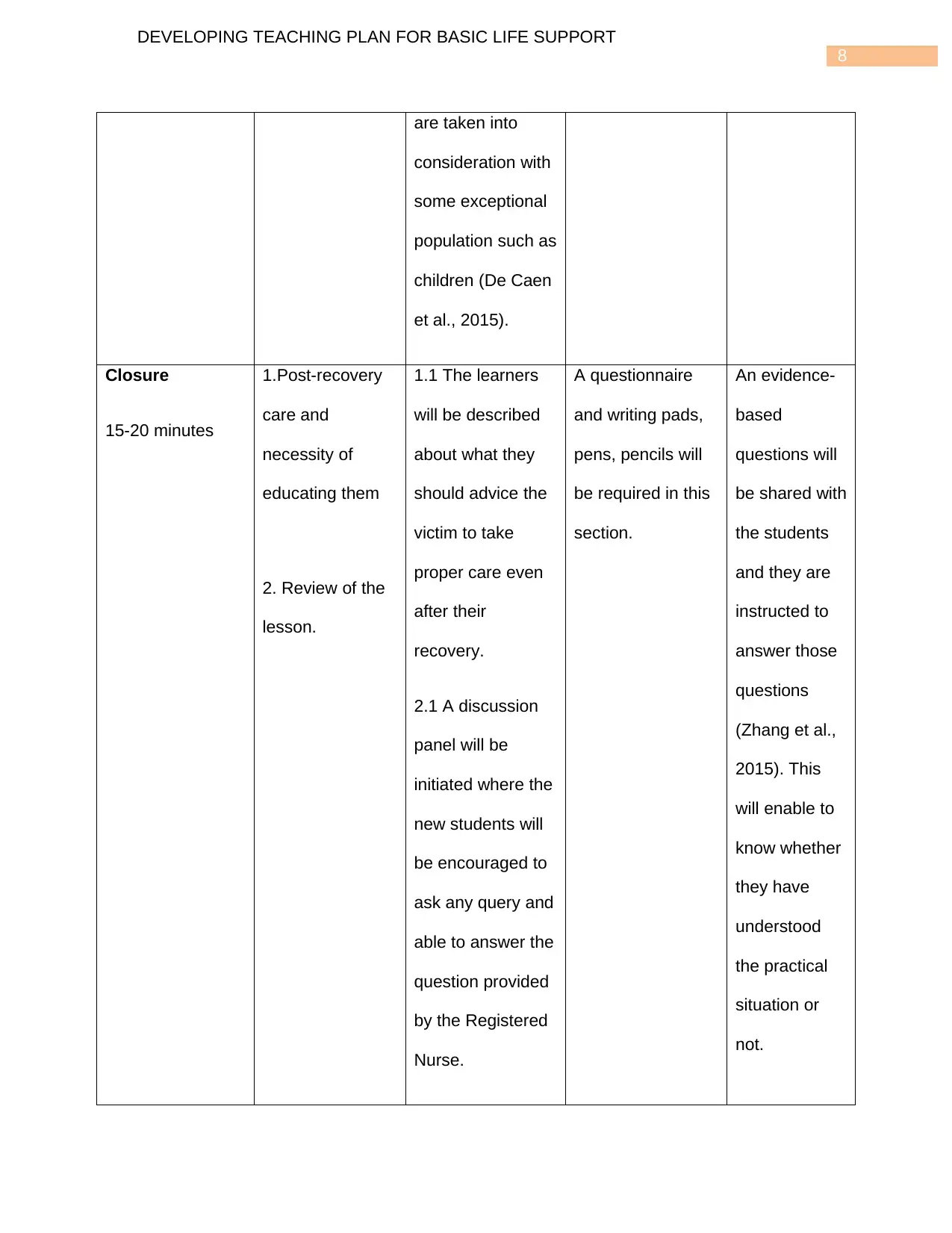
8
DEVELOPING TEACHING PLAN FOR BASIC LIFE SUPPORT
are taken into
consideration with
some exceptional
population such as
children (De Caen
et al., 2015).
Closure
15-20 minutes
1.Post-recovery
care and
necessity of
educating them
2. Review of the
lesson.
1.1 The learners
will be described
about what they
should advice the
victim to take
proper care even
after their
recovery.
2.1 A discussion
panel will be
initiated where the
new students will
be encouraged to
ask any query and
able to answer the
question provided
by the Registered
Nurse.
A questionnaire
and writing pads,
pens, pencils will
be required in this
section.
An evidence-
based
questions will
be shared with
the students
and they are
instructed to
answer those
questions
(Zhang et al.,
2015). This
will enable to
know whether
they have
understood
the practical
situation or
not.
DEVELOPING TEACHING PLAN FOR BASIC LIFE SUPPORT
are taken into
consideration with
some exceptional
population such as
children (De Caen
et al., 2015).
Closure
15-20 minutes
1.Post-recovery
care and
necessity of
educating them
2. Review of the
lesson.
1.1 The learners
will be described
about what they
should advice the
victim to take
proper care even
after their
recovery.
2.1 A discussion
panel will be
initiated where the
new students will
be encouraged to
ask any query and
able to answer the
question provided
by the Registered
Nurse.
A questionnaire
and writing pads,
pens, pencils will
be required in this
section.
An evidence-
based
questions will
be shared with
the students
and they are
instructed to
answer those
questions
(Zhang et al.,
2015). This
will enable to
know whether
they have
understood
the practical
situation or
not.
⊘ This is a preview!⊘
Do you want full access?
Subscribe today to unlock all pages.

Trusted by 1+ million students worldwide
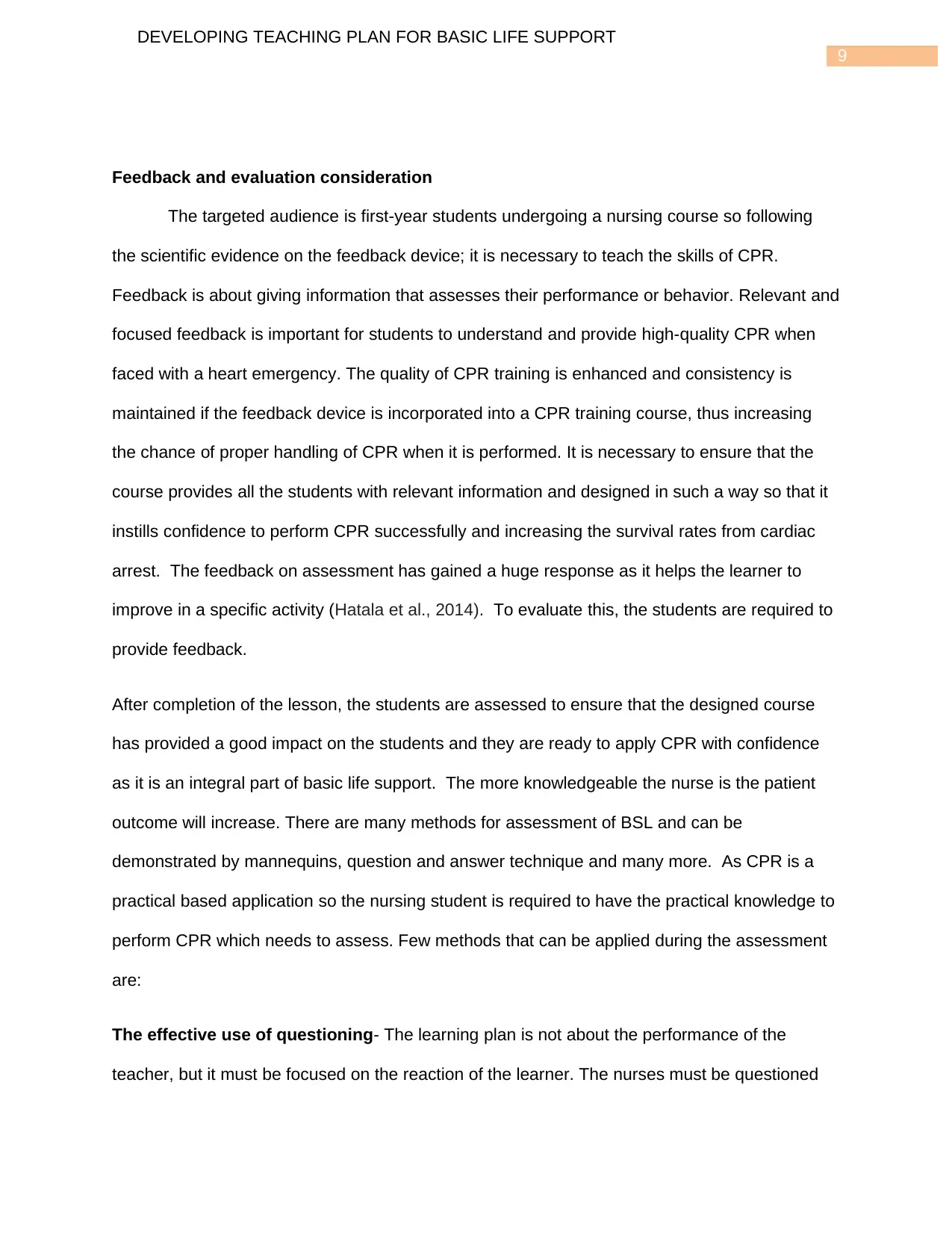
9
DEVELOPING TEACHING PLAN FOR BASIC LIFE SUPPORT
Feedback and evaluation consideration
The targeted audience is first-year students undergoing a nursing course so following
the scientific evidence on the feedback device; it is necessary to teach the skills of CPR.
Feedback is about giving information that assesses their performance or behavior. Relevant and
focused feedback is important for students to understand and provide high-quality CPR when
faced with a heart emergency. The quality of CPR training is enhanced and consistency is
maintained if the feedback device is incorporated into a CPR training course, thus increasing
the chance of proper handling of CPR when it is performed. It is necessary to ensure that the
course provides all the students with relevant information and designed in such a way so that it
instills confidence to perform CPR successfully and increasing the survival rates from cardiac
arrest. The feedback on assessment has gained a huge response as it helps the learner to
improve in a specific activity (Hatala et al., 2014). To evaluate this, the students are required to
provide feedback.
After completion of the lesson, the students are assessed to ensure that the designed course
has provided a good impact on the students and they are ready to apply CPR with confidence
as it is an integral part of basic life support. The more knowledgeable the nurse is the patient
outcome will increase. There are many methods for assessment of BSL and can be
demonstrated by mannequins, question and answer technique and many more. As CPR is a
practical based application so the nursing student is required to have the practical knowledge to
perform CPR which needs to assess. Few methods that can be applied during the assessment
are:
The effective use of questioning- The learning plan is not about the performance of the
teacher, but it must be focused on the reaction of the learner. The nurses must be questioned
DEVELOPING TEACHING PLAN FOR BASIC LIFE SUPPORT
Feedback and evaluation consideration
The targeted audience is first-year students undergoing a nursing course so following
the scientific evidence on the feedback device; it is necessary to teach the skills of CPR.
Feedback is about giving information that assesses their performance or behavior. Relevant and
focused feedback is important for students to understand and provide high-quality CPR when
faced with a heart emergency. The quality of CPR training is enhanced and consistency is
maintained if the feedback device is incorporated into a CPR training course, thus increasing
the chance of proper handling of CPR when it is performed. It is necessary to ensure that the
course provides all the students with relevant information and designed in such a way so that it
instills confidence to perform CPR successfully and increasing the survival rates from cardiac
arrest. The feedback on assessment has gained a huge response as it helps the learner to
improve in a specific activity (Hatala et al., 2014). To evaluate this, the students are required to
provide feedback.
After completion of the lesson, the students are assessed to ensure that the designed course
has provided a good impact on the students and they are ready to apply CPR with confidence
as it is an integral part of basic life support. The more knowledgeable the nurse is the patient
outcome will increase. There are many methods for assessment of BSL and can be
demonstrated by mannequins, question and answer technique and many more. As CPR is a
practical based application so the nursing student is required to have the practical knowledge to
perform CPR which needs to assess. Few methods that can be applied during the assessment
are:
The effective use of questioning- The learning plan is not about the performance of the
teacher, but it must be focused on the reaction of the learner. The nurses must be questioned
Paraphrase This Document
Need a fresh take? Get an instant paraphrase of this document with our AI Paraphraser
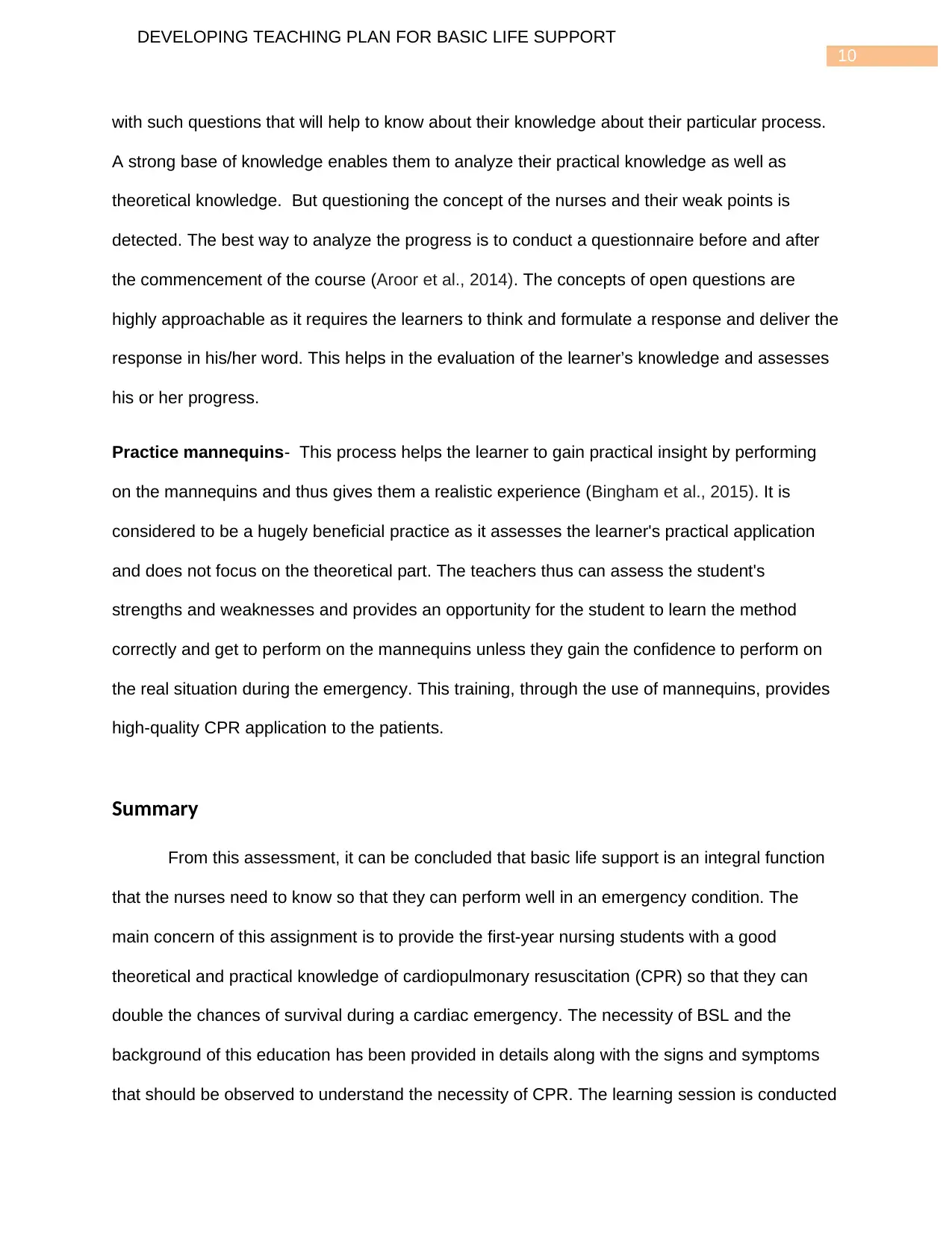
10
DEVELOPING TEACHING PLAN FOR BASIC LIFE SUPPORT
with such questions that will help to know about their knowledge about their particular process.
A strong base of knowledge enables them to analyze their practical knowledge as well as
theoretical knowledge. But questioning the concept of the nurses and their weak points is
detected. The best way to analyze the progress is to conduct a questionnaire before and after
the commencement of the course (Aroor et al., 2014). The concepts of open questions are
highly approachable as it requires the learners to think and formulate a response and deliver the
response in his/her word. This helps in the evaluation of the learner’s knowledge and assesses
his or her progress.
Practice mannequins- This process helps the learner to gain practical insight by performing
on the mannequins and thus gives them a realistic experience (Bingham et al., 2015). It is
considered to be a hugely beneficial practice as it assesses the learner's practical application
and does not focus on the theoretical part. The teachers thus can assess the student's
strengths and weaknesses and provides an opportunity for the student to learn the method
correctly and get to perform on the mannequins unless they gain the confidence to perform on
the real situation during the emergency. This training, through the use of mannequins, provides
high-quality CPR application to the patients.
Summary
From this assessment, it can be concluded that basic life support is an integral function
that the nurses need to know so that they can perform well in an emergency condition. The
main concern of this assignment is to provide the first-year nursing students with a good
theoretical and practical knowledge of cardiopulmonary resuscitation (CPR) so that they can
double the chances of survival during a cardiac emergency. The necessity of BSL and the
background of this education has been provided in details along with the signs and symptoms
that should be observed to understand the necessity of CPR. The learning session is conducted
DEVELOPING TEACHING PLAN FOR BASIC LIFE SUPPORT
with such questions that will help to know about their knowledge about their particular process.
A strong base of knowledge enables them to analyze their practical knowledge as well as
theoretical knowledge. But questioning the concept of the nurses and their weak points is
detected. The best way to analyze the progress is to conduct a questionnaire before and after
the commencement of the course (Aroor et al., 2014). The concepts of open questions are
highly approachable as it requires the learners to think and formulate a response and deliver the
response in his/her word. This helps in the evaluation of the learner’s knowledge and assesses
his or her progress.
Practice mannequins- This process helps the learner to gain practical insight by performing
on the mannequins and thus gives them a realistic experience (Bingham et al., 2015). It is
considered to be a hugely beneficial practice as it assesses the learner's practical application
and does not focus on the theoretical part. The teachers thus can assess the student's
strengths and weaknesses and provides an opportunity for the student to learn the method
correctly and get to perform on the mannequins unless they gain the confidence to perform on
the real situation during the emergency. This training, through the use of mannequins, provides
high-quality CPR application to the patients.
Summary
From this assessment, it can be concluded that basic life support is an integral function
that the nurses need to know so that they can perform well in an emergency condition. The
main concern of this assignment is to provide the first-year nursing students with a good
theoretical and practical knowledge of cardiopulmonary resuscitation (CPR) so that they can
double the chances of survival during a cardiac emergency. The necessity of BSL and the
background of this education has been provided in details along with the signs and symptoms
that should be observed to understand the necessity of CPR. The learning session is conducted
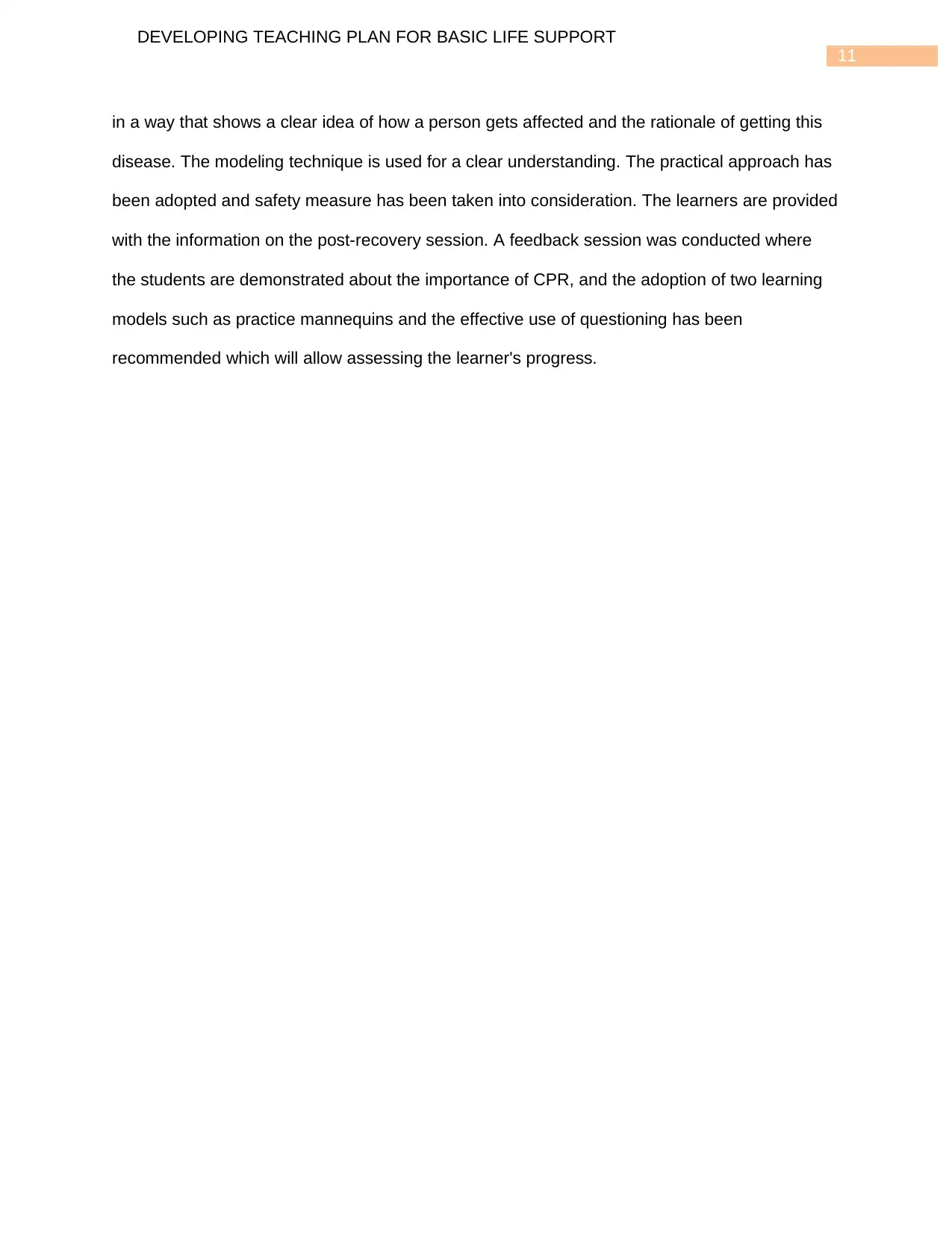
11
DEVELOPING TEACHING PLAN FOR BASIC LIFE SUPPORT
in a way that shows a clear idea of how a person gets affected and the rationale of getting this
disease. The modeling technique is used for a clear understanding. The practical approach has
been adopted and safety measure has been taken into consideration. The learners are provided
with the information on the post-recovery session. A feedback session was conducted where
the students are demonstrated about the importance of CPR, and the adoption of two learning
models such as practice mannequins and the effective use of questioning has been
recommended which will allow assessing the learner's progress.
DEVELOPING TEACHING PLAN FOR BASIC LIFE SUPPORT
in a way that shows a clear idea of how a person gets affected and the rationale of getting this
disease. The modeling technique is used for a clear understanding. The practical approach has
been adopted and safety measure has been taken into consideration. The learners are provided
with the information on the post-recovery session. A feedback session was conducted where
the students are demonstrated about the importance of CPR, and the adoption of two learning
models such as practice mannequins and the effective use of questioning has been
recommended which will allow assessing the learner's progress.
⊘ This is a preview!⊘
Do you want full access?
Subscribe today to unlock all pages.

Trusted by 1+ million students worldwide
1 out of 16
Related Documents
Your All-in-One AI-Powered Toolkit for Academic Success.
+13062052269
info@desklib.com
Available 24*7 on WhatsApp / Email
![[object Object]](/_next/static/media/star-bottom.7253800d.svg)
Unlock your academic potential
Copyright © 2020–2025 A2Z Services. All Rights Reserved. Developed and managed by ZUCOL.





